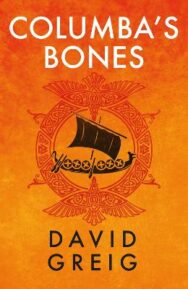‘With books by Denise Mina, Alan Warner and Jenni Fagan already published, Polygon’s Darkland Tales series is already enjoying a reputation for excellence that Columba’s Bones will only enhance.’
Rooted in the real history of Iona and its early monks, Columba’s Bones by David Greig is an utterly unique and thrilling read. In this review, David Robinson shares his thoughts about the book.
Columba’s Bones
By David Greig
Published by Polygon
Here’s the set-up. It’s 825AD and Grimur the Viking has become detached from the rest of the party raiding Iona, so instead of murdering the monks in the abbey he finds himself fighting a blacksmith. As he runs him through with his sword, ‘his eyes met the smith’s in an awkward moment of intimacy’.
We’re on Page 15 of playwright David Greig’s first novel, and I imagine he hasn’t written too many sentences like that. If Columba’s Bones had been a play – maybe another culture-clash drama like his Adventures with the Pictish People, but with Vikings and Christians instead of Romans and Picts – there would be a simple stage direction: [Blacksmith dies]. Now, however, Greig is working with a bigger paintbox. He has to describe a death, along with everything else, on top of his usual focus on credible, deepening dialogue.
Those, however, are only the basics. When he introduces the two other main characters – Brother Martin, for example, the only monk to survive the Viking raid, or Una, the blacksmith’s wife – he has to work out just how far he is going to wade into the past. Too little, and we’re nowhere near 825AD. Too far, and we’ll drown in it long before page 15.
Greig gets the balance just right. His narrative sounds suitably saga-like, so Grimur’s ‘hurt-causers’ will take the ‘whale road’ in their ‘wooden war-gull’, but short, punchy sentences, paragraphs and indeed chapters prevent any risk of pastiche. The dialogue is as convincing as one would expect, as is his use of metaphor. Grimur is, we are told, a bit of a poet and ‘the sand of his mind-beach was rich in words’. I love that. A mind-beach: where else would a Viking look for words for his adventures across the seas? Look up to the sky, and what will a Viking see? Lines of geese crossing ‘in straggled runes’. Again, just a tiny word-flick into a different world; again, just the right one.
Inevitably, one reads Columba’s Bones wondering what kind of play Greig would have made of it. The core of the story is certainly dramatic enough: Grimur charges onto Iona with his leader’s shouted ‘Two shares of silver to whoever guts the first Godfish!’ still ringing in his ears. Hungover and left for dead by his fellow-Vikings, who sail away with all but two of the islanders killed, will he try to rejoin them, and hunt down the buried silver reliquary containing the saint’s bones as a gift? Or will he be changed by those islanders, his hard heart softened by a woman’s touch or a monk’s prayers? Either way, what will happen when the Vikings return to Iona as they surely will, because ‘northmen are like midges: once they find you, they never leave you alone’?
It’s easy to imagine much of this working equally well as a play. And central to any play on the subject would be the scene in which the Iona monks, hearing the raiders storm ashore, line up in the chapel, looking forward to martyrdom, singing their prayers.
But as the first monk is killed, the novelist has the huge advantage of being able to write a sentence like this:
‘At that moment, the Holy Spirit passed through the brothers,
bringing each a shuddering gasp of joy.’
And if you want to know what that feels like, again the novelist can help rather more easily than the dramatist:
‘Suddenly the air was full of the laughter that follows a really good joke. But instead of laughter, these were great, heaving, body breaths of love. Alleluia! The brothers shouted as one.’
On stage, no matter how good the actors, that holy massacre could all so easily be a bloody mess. In a novel, it’s not. The reader is already tuning in, not to the expressions of the actors, not to the violence and the squirting of stage blood, but that great invisible thing at the heart of this story: faith. Because faith is what changes and charges everything. The believers on Iona just know that the buried bones of St Colm make it a holy place: they can heal sick children, ward off illness and make pagans follow Christ. And, er, that last bit: Greig only has to mention it and our minds are racing ahead: is this what is going to happen to Grimur?
One more example. Guess what’s going on here:
‘Imagine a falcon, looking down on a jarl’s garden in winter. A golden wall surrounds the garden and also divides it in two, neatly down the middle. The top of the wall is studded with colourful jewels: ruby, amber, blue john and quartz. The stones sparkle and catch the light.’
That’s right: this is Grimur’s first sight of an illustrated manuscript. The description continues for another couple of paragraphs, but you get the drift. We are being shown enchantment, amazement: the Viking has never seen anything like this before. Yes, an actor can show that, but we see it more clearly, as here, from inside his mind. And we’re inside Brother Martin’s mind too as he toils away inside the scriptorium on those very illustrations, aching to be one with God.
The dialogue between Grimur and Martin, pagan and Christian, warrior and pacifist, would clearly be the beating heart of this story if it were written as a play. And because Greig has the knack of getting into his characters’ minds and distilling their thoughts, I don’t doubt that it could still be made to work on the stage. Before I read it, that’s essentially what I expected this book to be: a play about violence, religion and redemption merely nudged towards a novel.
Wrong, wrong, wrong. Greig can, it turns out, not only use all the tools in the novelist’s toolbox but do so with confident expertise. He has clearly done his research into early Celtic Christianity and ninth-century peasant life, but at no stage does he obtrusively show off. Somehow, he creates a whole world that is the opposite of our own, where an anchoress could blithely ask to be bricked up in a cell for the rest of her life or an abbot demand that his monks pray, read or do any of God’s tasks until they cry, and where all of that makes some kind of sense.
Finally, let’s get back to Page 15, because there’s something else there I should have mentioned right at the start. Before Grimur runs the blacksmith through with his sword, he has already chopped off his left arm with his axe:
‘Even as he turned his shoulders, Grimur knew it was a good swing. Sometimes you just know.’
There will be a few more similar nods to Quentin Tarantino before this book is over, and I must admit I wasn’t expecting them. There were plenty of laugh-out-loud moments in the story too, not least in how the two central male characters avoided predictable fates and how the blacksmith’s wife almost didn’t. Another surprise, and one almost as pleasant as discovering a debut novelist as talented as this.
With books by Denise Mina, Alan Warner and Jenni Fagan already published, Polygon’s Darkland Tales series is already enjoying a reputation for excellence that Columba’s Bones will only enhance. Next year, Val McDermid will doubtless add to it with her take on Lady Macbeth. By the pricking of my thumbs, something wicked this way comes, as another playwright once wrote.
ALSO IN THIS ISSUE

 Wild Hope: Healing Words to Find Hope in Dark Days
Wild Hope: Healing Words to Find Hope in Dark Days
‘you may not consider poetry important / but if you had seen / a poem breathe life / into empty lung …

 Nothing But a Set of Eyes For Stars
Nothing But a Set of Eyes For Stars
‘On this crisp dark autumnal night in the Riverside area of Stirling, officially-a-city-but-really-i …













